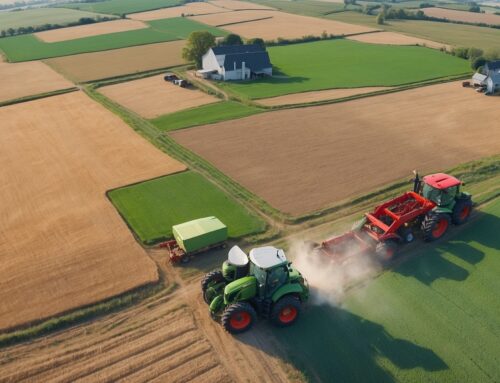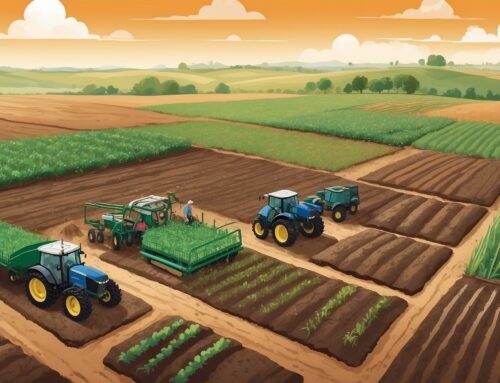Howdy, fellow farmers! You ever feel like we’re in a constant battle with the unknown? Weather, soil, pests—it seems like everything’s got its own agenda, and we’re just trying to keep up. But what if I told you that some shiny new tech is coming down the line that might just give us a fighting chance at keeping things in our favor? We’re talking the kind of stuff that’ll make future generations wonder how we ever managed to farm without it. Grab your coffee, and let’s dig into some of the wild, emerging technologies that are set to revolutionize the way we farm.
1. Swarm Robotics: More Than Just a Sci-Fi Plot
You know how we sometimes say, “If only I had a dozen more hands”? Well, that’s where swarm robotics comes in. Imagine a whole team of tiny robots, each specialized in one task—pulling weeds, spreading nutrients, inspecting crops—working together like bees in a hive. These little guys could be the ultimate farmhands, and they never get tired (or demand coffee breaks). It sounds like something straight out of a sci-fi movie, but swarm robotics is being developed to tackle the repetitive, labor-intensive tasks that can eat up our time. And if we’re being honest, getting a robot to handle some of the muckier work? Sounds good to me!
2. Blockchain: Not Just for Cryptocurrency Anymore
I know what you’re thinking—isn’t blockchain that fancy tech behind Bitcoin and all those internet currencies? Well, turns out, blockchain’s got some farming potential, too. Imagine being able to trace every bag of grain or crate of produce back to the exact field it came from, verifying its journey every step of the way. This is about transparency and trust. Blockchain can help us verify the quality of our produce, build stronger relationships with buyers, and eliminate any of those mystery issues that pop up in the supply chain. It’s like keeping a permanent record that no one can fudge—not even that guy down the road who insists his pumpkins are the biggest every year.

3. Gene Editing: Fine-Tuning Crops for Resilience
Ah, gene editing. Now before anyone runs off yelling “Frankenfood!” let’s be clear—this is about precision. Imagine if we could tweak our corn or wheat so it’s just a little more resistant to drought, or so those pesky insects aren’t quite as fond of it. CRISPR technology is making it possible to edit plant genes to improve yield, enhance disease resistance, or even adjust flavor. It’s like taking the crossbreeding that our grandfathers used to do, except with laser precision, and in a fraction of the time. Plus, if we could grow tomatoes that don’t taste like wet cardboard, I think we’d all be a little happier.
4. Hyper-Local Weather Forecasting: A Weatherman You Can Trust
We all know the local weather guy isn’t always spot-on—sometimes I think they just spin a wheel and call it a day. But hyper-local weather forecasting is set to change all that. With IoT devices, drones, and AI, these new systems can give you weather predictions specific to your fields—not just the whole county. Think of it like having a weather station for every acre, giving you insights into what’s happening where it matters most. If there’s a storm brewing that’s going to drench only the east field, now you’ll know. Finally, a weather forecast that might actually help us stay ahead of Mother Nature’s whims.
5. Vertical Farming: Growing Up Instead of Out
Now, this one’s a little different. Imagine growing lettuce, herbs, or even strawberries—not in the back forty, but inside a giant warehouse. Vertical farming means stacking plants high, using less space, less water, and controlling every aspect of their environment. Sure, it might not replace row crops any time soon, but for some of those delicate veggies, it’s a game-changer. No more worrying about late frost or pests chewing through your profits before you can harvest. Vertical farming gives us control, year-round production, and a whole lot less stress.
6. Biodegradable Sensors: The Future of Soil Monitoring
By now, we’re all used to the idea of sensors helping us keep track of our soil health. But what if I told you the next big thing is sensors that just melt away when we’re done with them? Biodegradable sensors are being developed that can monitor nutrients, moisture, and even root growth, and then simply degrade back into the earth. No mess, no need for retrieval. You plant ‘em, they tell you what’s up, and then they’re gone. It’s like the ultimate hands-off tool—set it, forget it, and let it become part of the soil again.
7. Smart Livestock Management: Happy Cows, Better Dairy
We can’t forget our four-legged friends! Smart livestock management is making it easier to keep our cows happy and healthy. With wearable devices, we can now monitor everything from temperature to activity levels, giving us real-time insights into herd health. If Bessie’s not moving around as much as usual, we’ll get an alert and can check on her before things get worse. And let’s be real—happy cows make for better dairy, and nobody likes dealing with a cranky heifer.
The Future Is Closer Than You Think
So there you have it—swarm robotics, blockchain, gene editing, hyper-local weather forecasts, vertical farming, biodegradable sensors, and smart livestock management. It’s a lot to take in, but each of these innovations brings us closer to a future where farming isn’t just about hard work and a bit of luck—it’s about precision, efficiency, and sustainability. Whether we’re talking about improving yields, reducing inputs, or just keeping our cows in good spirits, these technologies are setting the stage for the next great agricultural revolution.
And hey, if it means a little less guesswork and a little more time to kick back at the end of a long day—count me in. Here’s to the future, y’all!





